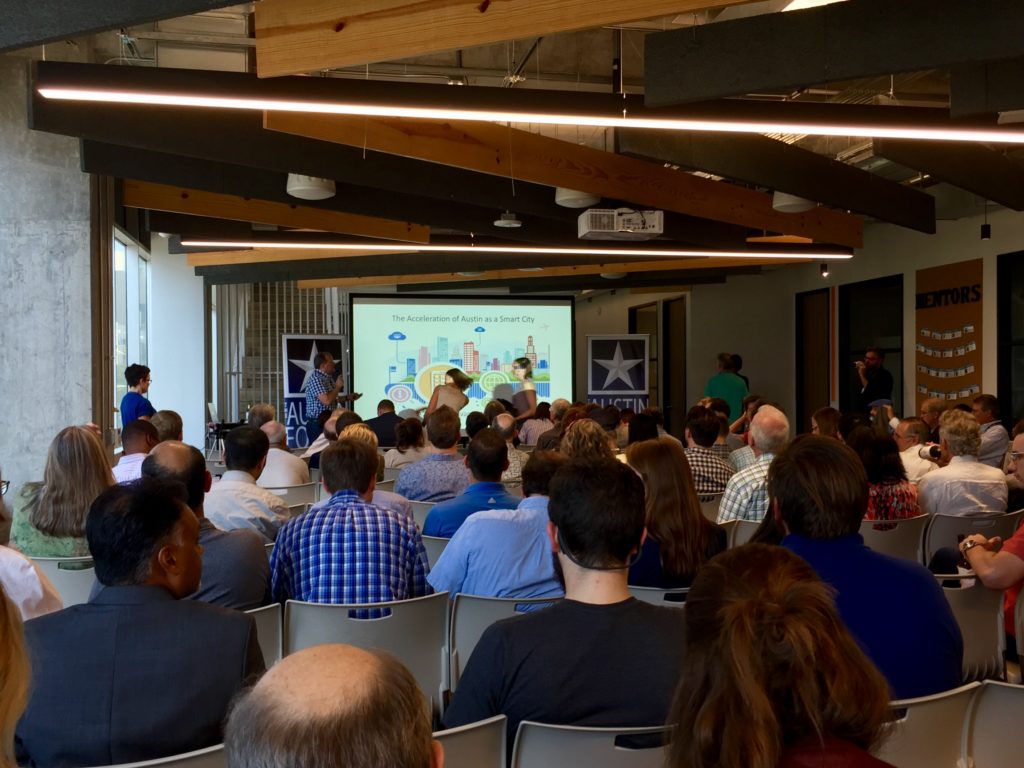The Austin Forum is a monthly speaking event that explores the impact of technology on society and stimulates discussions, collaborations, and partnerships on new technology opportunities.
June’s version took place this past Thursday, where City of Austin leaders were welcomed to Galvanize by a full house eager to learn more about the City’s acceleration as a smart city. ATA’s executive director David Edmonson attended, and here are his three takeaways from the evening:
#1 — What’s a smart city? Depends on who you ask.
Jay Boisseau, the Austin Forum’s director, set the stage with his definition of “smart city:”
“A smart city uses technology to collect more and better data, and performs data analytics to make better decisions that improve all aspects of city life, services, infrastructure, and environment.”
Jay discussed how a smart city allows the city itself to benefit by relying on data-informed decisions, which could range from automated decisions like traffic lights that adjust on their own based on weather or events — or better human decisions by city staff like planning.
Stephen Elkins, the City of Austin’s Chief Information Officer, and Ben Guhin, the City’s Senior Advisor for Design & Technology, discussed how Austin came to its own definition after being tasked by City Council to develop a Smart City Strategic Roadmap. Beginning with the definition adopted by the International Standards Organization, staff tweaked it to make it Austin-centric and representative of the community’s values:

Regardless of how exactly you define it, no city has completely gotten there just yet. As former U.S. Secretary of Transportation Anthony Foxx put it:

#2 — Cities matter, so becoming smarter is essential.
But there’s more reason than ever to work toward the goal of becoming that first truly smart city, as cities are increasingly important: half of the world’s population lives on only one percent of its land.

Here in the United States, 62.7 percent of the population live in cities that comprise only 3.5 percent of the land area.
As cities across the world — and here in Austin — continue to expand, managing that growth in a sustainable manner is imperative. As the United Nations noted in 2014:
If well managed, cities offer important opportunities for economic development and for expanding access to basic services, including health care and education, for large numbers of people. Providing public transportation, as well as housing, electricity, water and sanitation for a densely settled urban population is typically cheaper and less environmentally damaging than providing a similar level of services to a dispersed rural population.
Smart cities efforts therefore have the opportunity to help address or mitigate the impacts of population growth via the increased migration into cities, aid with the transition to a renewable energy future, and construct a more resilient and green built infrastructure.
But these technologies don’t exist in a vacuum. They’re inevitably interrelated, and actions taken by a city in one focus area will impact others. As a result, cities like Austin recognize they need to approach smart cities efforts in a, well, strategic way.
#3 — Being “smart” isn’t enough. You have to know what problem you’re solving first.
In response to a question posed by Chelsea Collier during the evening’s Q&A session, Ben Guhin replied that it’s easier to know when you have a dumb city than when you have a smart city.
His point drew some chuckles from the audience, but Ben’s point—inefficiencies often lead to much more public outrage and input than efficiencies — is correct. So as City staff looks to move into smart city projects, they’re making a concerted effort to plan properly by first identifying the problem they hope to solve.
Ben elaborated on this by outlining the six “smart building blocks” discussed in Austin’s Smart City Strategic Roadmap.

Each of those building blocks are dependent on one another, something that Chief Innovation Officer Kerry O’Connor pointed out in response to a previous ATA piece on smart kiosks:
To address the original article, Digital Solutions for the Streets of Austin — Benefits of Smart Kiosks and Why Austin Isn’t There Yet, to get to the point of being able to implement smart kiosks, I would first choose the building block of smart team and smart service, before the building block of smart policy. Assemble a team, and then figure out how to connect these kiosks to a problem worth solving, so that the kiosk offers a service to help people get what they really need from the city. Then, with that imperative, and that team, it becomes much easier to make modifications to the Downtown design standards that keep our streets looking awesome. [ATA’s emphasis]
Stephen Elkins affirmed the need to identify the problem first from a logistical perspective: as the City’s Chief Information Officer, he needs to budget for the discovery process before the City budgets for the technology.
. . .
If you want to learn more about upcoming Austin Forum events, check their website to see what’s scheduled next. To view the slides from June’s Austin Forum event, click here.

